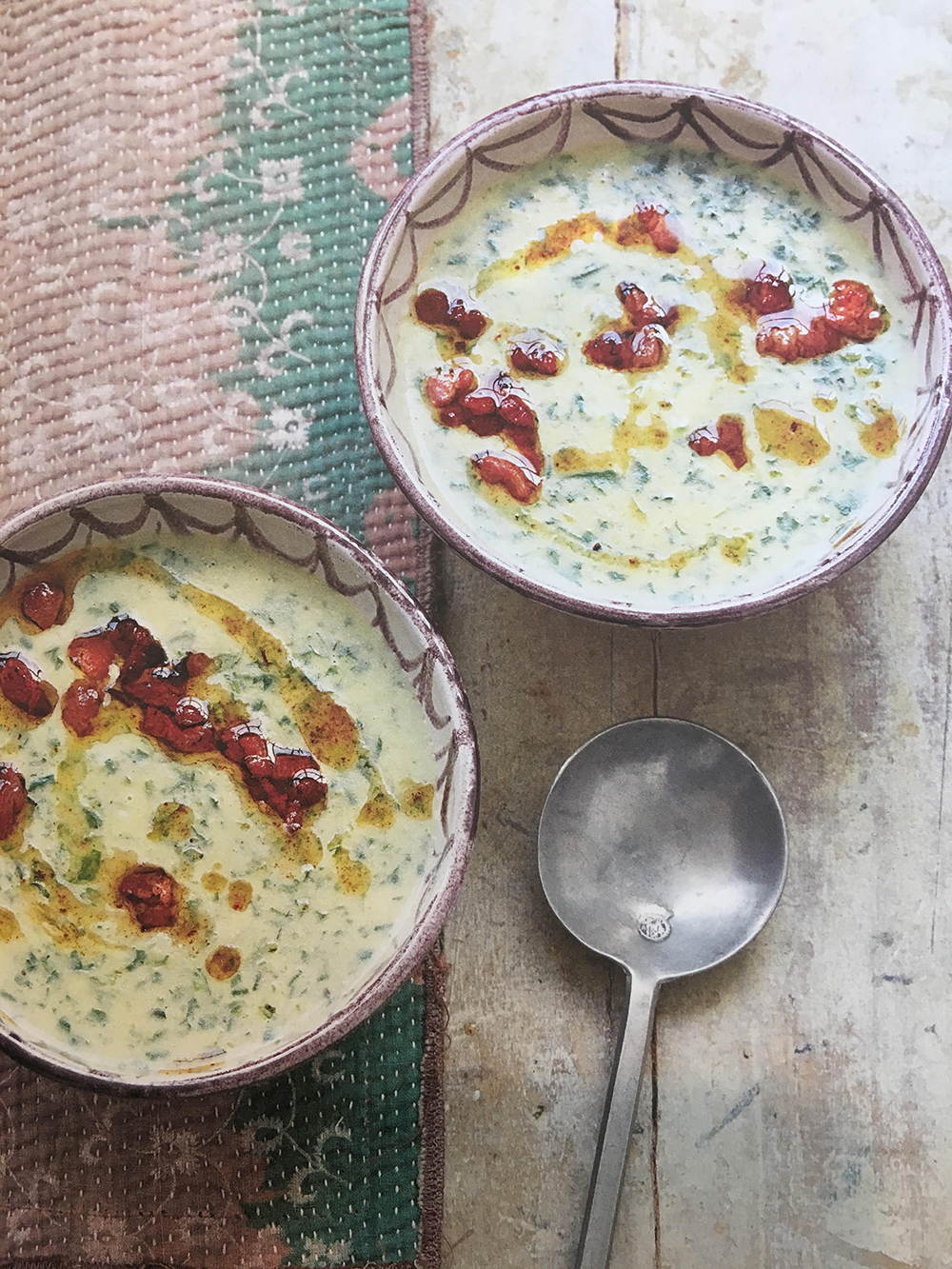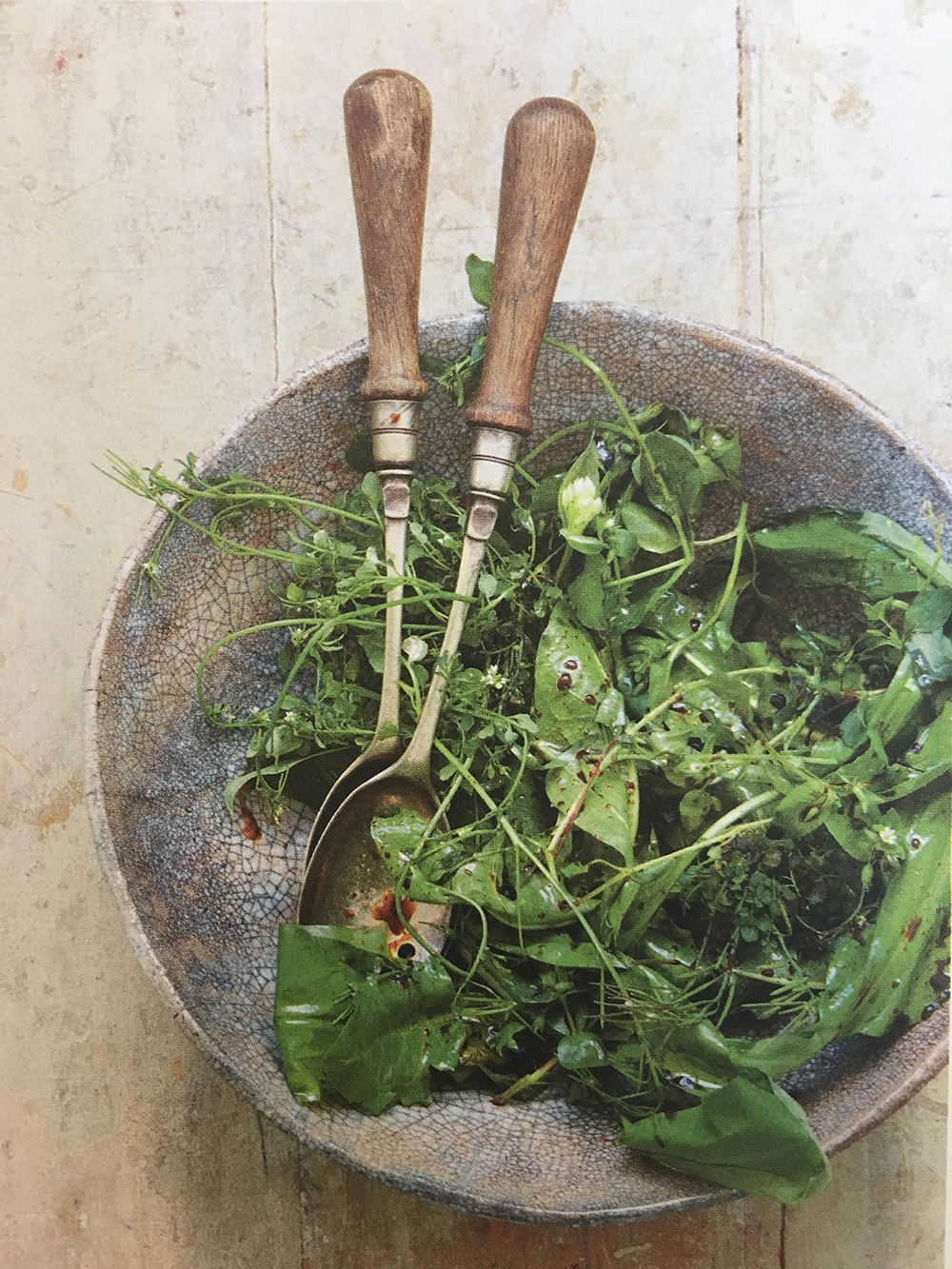The Darina Allen Column
 Foraging for wild foods with my little basket on my arm is definitely up there with my favourite pastimes. I’ve been sharing my enthusiasm ever since we offered the first foraging course here at the Ballymaloe Cookery School over 20 years ago in the Autumn of 1998. I’d just come back from Vancouver Island where I met Sinclair Phillips at Sooke Harbour House. He introduced me to their ‘in house’ forager who collected the wild foods and seaweeds to incorporate into every course on the Sooke Harbour House menu, Sinclair even dived for the scallops. I was intrigued and realised that what I had been doing as a child, collecting watercress, berries, nuts and field mushrooms in Autumn, had an exciting name...
Foraging for wild foods with my little basket on my arm is definitely up there with my favourite pastimes. I’ve been sharing my enthusiasm ever since we offered the first foraging course here at the Ballymaloe Cookery School over 20 years ago in the Autumn of 1998. I’d just come back from Vancouver Island where I met Sinclair Phillips at Sooke Harbour House. He introduced me to their ‘in house’ forager who collected the wild foods and seaweeds to incorporate into every course on the Sooke Harbour House menu, Sinclair even dived for the scallops. I was intrigued and realised that what I had been doing as a child, collecting watercress, berries, nuts and field mushrooms in Autumn, had an exciting name...
Now we schedule 3 or 4 Foraging courses every year, one in every season and they are invariably oversubscribed – An introduction to gathering wild and free food can be life changing…where others see weeds and wildflowers I see dinner...
For many, identifying and gathering food in the wild is really a ‘forgotten skill’ but one well worth acquiring. All these foods have either medicinal or culinary uses and often both. A very high percentage of the plants around us are edible, some of course are not so it’s best to err on the side of caution as you add to your knowledge.
It’s good to know that these wild foods still have their full compliment of vitamins, minerals and trace elements, up to 20 times more than the ultra-processed food on which so many depend nowadays.
Foraging is often just associated with Autumn when there is an abundance of fruit nuts and berries, free for the gathering but every season produces it’s treasures even in the depths of Winter when we feast on bittercress, sorrel, alexanders….Spring brings primroses, wild garlic, hawthorn, sweet cicily, sea kale… Early Summer ground elder, purslane salad burnett, elderflowers ….in fact the Elderflowers have only just finished and those that remain on the trees are turning into elderberries which we’ll harvest in the Autumn to make syrups and jellies. We’ll dry some to add to scones, muffins or sauces to accompany game dishes.
On our recent Summer Foraging course we found over 50 different greens in the grounds of the Ballymaloe Cookery School and all along the seashore at Shanagarry strand and at Ballyandreen.
Often the perception is that one needs to go somewhere special to forage, along country lanes or into the woods, hedgerows and hillsides but in fact one can find wild foods everywhere and anywhere – in towns, villages and city parks. Avoid areas that may have been sprayed with pesticides or herbicides or where people regularly walk their dogs.
Once you begin to think foraging, one becomes much more aware of the wild foods around us in nature. Dandelions, nettles, other weeds….In Summer many of the plants are flowering so pick the edible flowers to scatter over salads, cakes or to decorate ‘wee buns’. Bring a gaggle of children with you, they love foraging. You’ll be astonished how knowledgeable and adventurous they become in a short time.
In recent years, foraging has become super cool for top chefs and cooks, the revolution was led by Rene Redzepi and his team at Noma in Copenhagen but nowadays you need to look no further than your local area… Pilgrim’s in Rosscarbary, The Mews in Baltimore, The Chestnut in Ballydehob, Ichigo Ichie are all in Cork, for example, and of course Ballymaloe House where Mytle Allen was incorporating wild foods into her menu since she opened her country house as a restaurant in 1964.
The next Foraging Course here at the Ballymaloe Cookery School will be on Saturday, 28th September. To book go to www.cookingisfun.ie Meanwhile, take a basket or pop a little bag in your pocket any time you go for a walk and gather some rich pickings to incorporate into your menu for optimum health. A walk in the country will never be the same again…
RECIPES
 Foragers Soup
Foragers Soup
Throughout the seasons one can gather wild greens on a walk in the countryside – foraging soon becomes addictive. Many greens are edible and some are immensely nutritious. Arm yourself with a good well-illustrated guide and be sure to identify carefully and if in doubt – don’t risk it until you are quite confident. Don’t overdo the very bitter herbs like dandelion.
Serves 6
50g (2ozs) butter
110g (4ozs) diced onion
150g (5 ozs) diced potatoes
250g (9ozs) chopped greens – alexanders, nettles, wild sorrel, a few young dandelions, wild garlic, borage leaves, wild rocket, ground elder, beech leaves, chickweed, watercress
600ml (1 pint) light chicken stock
600ml (1 pint) creamy milk
75g (3ozs) chorizo or lardons of streaky bacon
extra virgin olive oil
wild garlic flowers if available
Melt the butter in a heavy bottomed saucepan. When it foams, add potatoes and onions and turn them until well coated. Sprinkle with salt and freshly ground pepper. Cover and sweat on a gentle heat for 10 minutes. When the vegetables are almost soft but not coloured add the hot stock and boiling milk. Bring back to the boil and cook until the potatoes and onions are fully cooked. Add the greens and boil with the lid off for 2-3 minutes approx. until the greens are just cooked. Do not overcook or the soup will lose its fresh green colour. Purée the soup in a liquidiser. Taste and correct seasoning.
Heat a little oil in a frying pan. Add the diced chorizo or lardons of streaky bacon, cook over a medium heat until the fat starts to run and the bacon is crisp. Drain on kitchen paper. Sprinkle over the soup as you serve. Use the chorizo oil to drizzle over the soup also and scatter a few wild garlic flowers over the top if available.
New Potatoes with Dillisk Butter
This seaweed butter is a delicious accompaniment to floury potatoes, otherwise enjoy them with lots of good Irish butter.
Serves 4-5
2lbs (900g) new potatoes e.g., Home Guard, British Queens (the variety we grow is Colleen)
2 pints (1.2 litres) seawater or 2 pints (1.2 litres) tap water plus 1 teaspoon salt
a sprig of seaweed if available
Bring the seawater to the boil. Scrub the potatoes. Add salt if using tap water and a sprig of seaweed to the water, and then add the potatoes. Cover the saucepan, bring back to the boil and cook for 15-25 minutes or until fully cooked depending on size.
Drain and serve immediately in a hot serving dish with dillisk butter.
Note
It’s vitally important for flavour to add salt to the water when cooking potatoes.
Dillisk Butter:
110g (4oz) butter
1-2 tablespoons of chopped dillisk
This seaweed butter is a delicious accompaniment to floury potatoes, otherwise enjoy them with lots of good Irish butter.
 Foragers Salad
Foragers Salad
We use a mixture of foraged leaves for this salad. You are unlikely to have all of these so just add what you can find to a bowl of lettuces and salad leaves. This salad can be a best for pan grilled, fish, meat or some foraged cockles or mussels. In early Spring, we add some young beech and ground elder leaves. For maximum flavour pick the leaves when young.
A selection of wild leaves in season such as:
dandelion leaves
wild garlic
wild watercress
bittercress
chickweed
wild sorrel (buckler leaf or lamb’s tongue)
salad burnet
buckler leaf sorrel
pennywort (also known as bread and butter, walker’s friend and navelwort)
sweet cicely
red orach
Dressing:
3 tablespoons extra virgin olive oil or cold pressed organic rapeseed oil
1 tablespoon apple balsamic vinegar
1/2 teaspoon honey
sea salt and freshly ground black pepper
Allow a handful of wild leaves per person. Wash them carefully in cold water and dry them in a salad spinner. Keep chilled until ready to use.
To make the dressing, whisk the oil, vinegar and honey together. Season to taste.
Toss the dried leaves in just enough of the dressing to make them glisten. Taste a leaf to check that the seasoning is correct.
Serve immediately.
Meadow Sweet Panna Cotta
Panna cotta (‘cooked cream’), normally, is a somewhat bland vehicle for fruit or sauce. Here we infuse meadow sweat leaves and flowers but fig leaves are also delicious. This recipe comes from Yotam Ottolenghi, something of a charlatan, who prefers to make without cream at all, replacing it with yoghurt – both for a lightness of taste, and reduction of guilt.
Serves 4
3 sheets gelatine (2.5g each – ‘standard’ size)
400ml (14fl oz) whole milk
1 vanilla pod, split
25g (1oz) meadow sweet flowers or fresh fig leaves
100g (3 1/2oz) caster sugar
150ml (5fl oz) double cream (or 200g/7oz Greek yoghurt)
Soak the gelatine in cold water.
Bring the milk to a boil with the vanilla pod, and take it straight off the heat. Allow it to cool to about 70ºC/158?F, then add the meadow sweat flowers or fig leaves if using. Keep it around 60-70 oC/140-158?F (put over a low flame briefly if it cools below) for 5-15 minutes, and taste to judge when the infusion is correct (too long and it starts to taste bitter, too short and it will be bland).
When you’re happy, strain the milk and, while still hot, add the sugar and the soaked gelatine. Stir to dissolve. At room temperature, stir in the cream or yoghurt and portion into glasses or moulds.
Serve turned out onto little plates, just as they are or with some summer berries, wild strawberries would delicious.
Crystallised Flowers
Flowers and leaves crystallised with sugar will keep for months, although they may lose their initial vibrant colour. This is what we call a high-stool job – definitely a labour of love and not something suited to an impatient, Type A personality. The end result is both beautiful and rewarding and many family and staff wedding cakes have been embellished with crystallized flowers over the years.
Flowers and leaves must be edible and are all worth doing.
Smaller flowers are more attractive when crystallized e.g. primroses, violets, apple blossom, violas, rose petals….We crystallise lots of leaves as well as flowers so one can make attractive arrangements. Use fairly strong textured leaves - e.g. mint, lemon balm, sweet cecily, wild strawberry, salad burnet or marguerite daisy leaves.
The caster sugar must be absolutely dry, one could dry it in a low oven for about 30 minutes approx.
Break up the egg white slightly in a little bowl with a fork. Using a child's paintbrush, paint the egg white very carefully over each petal and into every crevice. Pour the caster sugar over the flower with a teaspoon. Arrange the crystallized flowers carefully on silicone paper so that they retain a good shape. Leave to dry overnight in a warm, dry place such as close to an Aga, over a radiator or in an airing cupboard. When properly crystallized, these flowers will last for months, even years, provided they are kept dry. We store them in a pottery jar or a tin box with an airtight lid.
HOT TIPS
FOOD – bigger than the plate…
For the first time the V&A museum in London has put on an exhibition on the subject of food – not to be missed….It takes us on a sensory journey through the food cycle, to explore the pleasure and the politics of food and the world around us presenting alternative food futures, from urban farming to gastronomic experiences. The exhibition continues until Sunday October 20th 2019. Put it on your London list – make time, it’s so worth it.
Another date for your diary…
The full programme for A Taste of West Cork Food Festival is available. A super exciting line up of events over two weeks 6th – 15th September, featuring cookery demonstrations, dinners and brunches with guest chefs. Food tastings, talks, exhibitions, farmers markets, children’s events and lots, lots more…over 250 events in 50 towns and villages all over West Cork and the 8 islands off the coast. Check it out, many of the events sell out early so save your place.
What’s on at Ballymaloe Cookery School…
The Afternoon Cookery Demonstrations at BCS are open to the public from Monday to Friday. Check out www.cookingisfun.ie to see the seasonal menus. The award winning gardens and farm walk are also open from 11am to 6pm Monday to Saturday. Don’t miss the Food Truck just outside the Ballymaloe Cookery School shop for brunch, light lunches, sweet treats and super delicious cakes and biscuits.





There are currently no comments
Leave a comment
Not a member? Register for your free membership now!
Or leave a comment by logging in with: